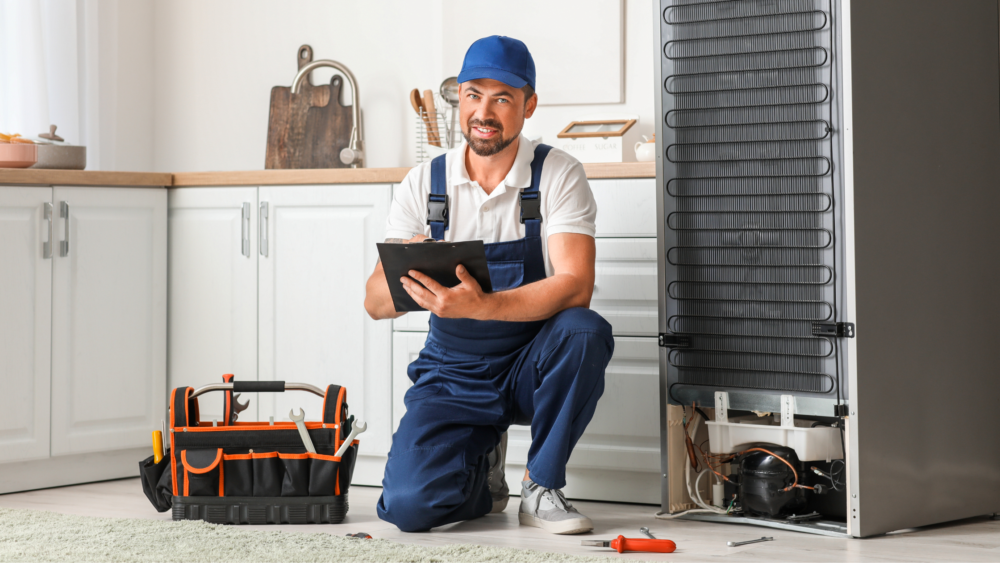Ever felt like your house has a mind of its own? One day it’s the cozy haven you love, and the next, you’re dealing with a leaking faucet that seems to mock you. Yes, we’ve all been there. Tackling common household problems can sometimes feel like playing whack-a-mole in your very own living room. But fear not! Whether it’s stubborn water leaks or uninvited pests making themselves at home, there are tried and tested ways to get back on top.
With an average ROI of 3800%, fixing these issues isn’t just about peace of mind; it’s also smart economics for homeowners looking to maintain or increase their property value. So let’s roll up our sleeves and address how you can turn these nuisances into mere blips on your radar.
Identifying and Fixing Common Household Plumbing Issues
Plumbing problems are a real pain. They’re one of the most common household issues that can quickly escalate from a minor inconvenience to a full-blown disaster if not addressed promptly.
From leaky faucets to clogged drains and overflowing toilets, these pesky problems can cause water damage and even lead to more serious structural issues if left unchecked. But don’t panic just yet.
Diagnosing Faucet Leaks
That incessant drip-drip-drip from your faucet isn’t just annoying; it’s also a huge waste of water. A single leaky faucet can waste up to 3,000 gallons of water per year. Yikes.
To diagnose the issue, first determine if the leak is coming from the spout or the base of the faucet. If it’s the spout, the problem is likely a worn-out washer or O-ring. If the leak is at the base, it could be a corroded valve seat or a loose packing nut.
Unclogging Drains Efficiently
Clogged drains are another common plumbing woe. Before reaching for harsh chemical drain cleaners, try these eco-friendly methods:
- Pour boiling water down the drain to break up grease and gunk
- Use a plunger to dislodge the clog with a bit of elbow grease
- Mix equal parts baking soda and vinegar, let it fizz, then flush with hot water
If these tricks don’t work, it may be time to call in a professional plumber to assess the situation.
Preventing Toilet Overflows
An overflowing toilet is every homeowner’s worst nightmare. To prevent this messy situation, avoid flushing anything other than waste and toilet paper. Keep a plunger nearby for minor clogs, and know where the main water shut-off valve is located in case of an emergency.
Regular maintenance, like replacing the flapper and fill valve every few years, can also help prevent leaks and overflows. Taking care of your plumbing now can really save you a headache and a hefty repair bill later on.
Essential Electrical Maintenance for Home Safety
Electrical problems are no joke. Faulty wiring and outdated systems can lead to shocks, fires, and other serious safety hazards. Don’t take chances when it comes to your home’s electrical health.
Checking for Faulty Wiring
Keep an eye out for warning signs of faulty wiring, such as flickering lights, buzzing outlets, or burning smells. If you notice any of these red flags, shut off power to the affected area immediately and call a licensed electrician.
Other red flags to watch out for include wires that look like they’ve seen better days, connections that aren’t as tight as they should be, and those old-school two-prong outlets. Don’t attempt to fix these issues yourself; leave it to the pros to ensure your safety and up-to-code repairs.
Replacing Outdated Electrical Systems
If your home is more than 40 years old, it may be time to upgrade your electrical system. Older homes often have insufficient wiring that can’t handle the demands of modern appliances and electronics.
Switching out your old electrical panel and wires for modern, code-compliant ones not only ramps up the safety of your home but also its efficiency and potential selling price down the line. It’s a big job, but one that’s well worth the investment in the long run.
Don’t forget about regular maintenance tasks, like testing GFCI outlets monthly and replacing smoke detector batteries annually. By taking these simple actions, you’re doing a world of good in protecting your home and loved ones from the risks associated with electricity.
Keeping Your Home Pest-Free
Pests are more than just a nuisance; they can also pose serious health risks and cause damage to your home. Tackling everything from those sneaky bugs to uninvited furry guests requires us to get ahead of the game with pest control.
Natural Remedies for Pest Control
Before reaching for harsh chemicals, try these natural pest control methods:
- Keep your home clean and free of crumbs and spills that attract pests
- Seal up cracks and crevices where pests can enter
- Use essential oils like peppermint or citrus to repel insects
- Set traps or use diatomaceous earth to get rid of crawling bugs
For larger infestations, you may need to call in a professional exterminator. When picking one, aim for those who are friends of the earth, using methods and products that keep your family and furry buddies safe from harm.
Securing Your Home Against Invasions
To keep pests from making themselves at home in your space, take these preventative measures:
- Store food in airtight containers and keep your kitchen clean
- Fix leaky pipes and eliminate standing water where pests breed
- Keep your yard tidy and trim back vegetation that touches your home
- Inspect packages and secondhand items before bringing them inside
Remember, even the cleanest homes can experience pest problems. Regular inspections and prompt action can help nip infestations in the bud before they get out of hand.
Enhancing Indoor Air Quality and Ventilation
Did you know that indoor air can be up to 5 times more polluted than outdoor air? Poor ventilation and air quality can lead to health issues like allergies, asthma, and even cognitive impairment. Yikes.
Installing Ventilation Fans
If you’re looking for a straightforward fix to better the air quality in your home, think about popping ventilation fans into spots where moisture loves to hang out – like your bathroom and kitchen. These fans help remove excess humidity, odors, and pollutants that can contribute to mold growth and poor air quality.
Look for fans with high CFM (cubic feet per minute) ratings and low noise levels for maximum effectiveness and comfort. Don’t forget to clean the fans regularly to prevent dust and grime buildup.
Using Air Purifiers Effectively
Air purifiers are a fantastic option if you’re looking to tackle those pesky airborne nasties like dust, pollen, and pet dander. When choosing an air purifier, look for models with HEPA filters that can trap particles as small as 0.3 microns.
Place the purifier in the room where you spend the most time, like your bedroom or living room, and run it continuously for best results. Remember to replace the filters regularly according to the manufacturer’s instructions.
In addition to these tech solutions, don’t forget the power of good old-fashioned fresh air. Open your windows when weather permits to let in a breeze and flush out stale indoor air. Your lungs (and your energy bills) will thank you.
Preventing Water Damage Through Roof and Gutter Maintenance
Your roof is your home’s first line of defense against the elements. Neglecting roof and gutter maintenance can lead to leaks, water damage, and even structural issues down the line. Don’t let a small problem turn into a big headache.
Regular Roof Inspections and Repairs
Schedule a professional roof inspection at least once a year to catch any potential problems early. Look for signs of damage like missing or cracked shingles, rust spots on flashing, and sagging or bulging areas.
If you notice any issues, don’t put off repairs. A small leak can quickly turn into a major problem if left unchecked. Hire a reputable roofing contractor to fix any damage promptly to prevent further deterioration.
Cleaning Gutters to Prevent Blockages
Clogged gutters can cause water to overflow and seep into your home’s foundation, leading to costly water damage. Clean your gutters at least twice a year (more if you have a lot of trees nearby) to remove leaves, twigs, and other debris.
Consider installing gutter guards to minimize blockages and make maintenance easier. These mesh screens fit over your gutters to keep debris out while still allowing water to flow freely.
Don’t forget about downspouts. Make sure they’re directing water away from your home’s foundation to prevent erosion and water damage. If necessary, add extensions to carry water at least 5 feet away from your house.
Quick Fixes for Minor Structural and Cosmetic Damages
Over time, even the most well-maintained homes can develop minor structural and cosmetic issues. Catching and fixing these problems early can save you from more extensive (and expensive) repairs down the road.
Repairing Cracks in Walls and Ceilings
Small cracks in walls and ceilings are often caused by settling, temperature changes, or humidity fluctuations. While they’re usually not a cause for concern, they can be unsightly and lead to further damage if left unrepaired.
To fix hairline cracks, start by cleaning the area and removing any loose debris. Fill the crack with spackling compound or joint compound using a putty knife, then sand smooth once dry. For larger cracks, you may need to use mesh tape or a bridging compound for added stability.
Touching Up Paint and Stain Marks
Scuffs, stains, and chipped paint can make your home look dingy and unloved. Luckily, these cosmetic issues are easy to fix with a little elbow grease and the right products.
For paint touch-ups, use a small brush or roller to apply a thin coat of matching paint over the damaged area. Blend the edges to create a seamless finish. For stains on walls or ceilings, try cleaning the area with a mixture of dish soap and warm water. If that doesn’t work, you may need to prime and paint over the stain to conceal it.
Don’t forget about other surfaces like wood trim, doors, and cabinets. Touch up scratches and dings with a matching stain pen or marker, then seal with a clear topcoat to protect the finish.
Optimizing Heating Systems for Efficiency and Safety
Your home’s heating system is a crucial component of your comfort and safety. Skipping out on routine upkeep can really throw a wrench in things, leading to your system working overtime (hello, sky-high energy bills.) and even putting you at risk for some serious safety hazards. So, to keep everything running like a well-oiled machine, here are some nifty tricks you’ll want to try out.
Regular Maintenance Checks
Schedule annual maintenance checks with a qualified HVAC technician to keep your heating system in top shape. During these checks, the technician will clean and inspect your system, replace filters, and make any necessary repairs or adjustments.
In between professional checks, do your part by changing filters monthly (or as recommended by the manufacturer) and keeping vents and registers clean and unobstructed. By doing this, you’ll not only give your system a boost in efficiency but also breathe easier with the noticeable improvement in air quality indoors.
Upgrading to Energy-Efficient Models
If your heating system is more than 15 years old, it may be time to consider an upgrade. Switching to the latest energy-saving models could not only shrink your utility bills but also ensure that your home stays evenly warm and cozy, no matter what.
Look for systems with high AFUE (Annual Fuel Utilization Efficiency) ratings, which measure how efficiently the system converts fuel to heat. The higher the rating, the more efficient the system.
Don’t forget about programmable thermostats. These handy devices allow you to set different temperatures for different times of day, so you’re not wasting energy heating an empty house. Some models even learn your preferences over time and adjust automatically.
Smart Solutions to Enhance Natural Light in Your Home
Letting natural light pour into your home doesn’t just make it feel more spacious and welcoming; it’s like a secret weapon for boosting your mood and kicking your productivity into high gear. If your space feels dark and dreary, try these smart solutions to bring in more sunshine.
Installing Mirrors Strategically
Slapping a few mirrors around your space is a clever, yet simple trick to make the most of natural light flooding into your home. Place a large mirror opposite a window to reflect light back into the room, making it feel brighter and more spacious.
You can also use mirrored furniture, like a mirrored coffee table or cabinet, to bounce light around the room. Just be mindful of placement to avoid glare or unwanted reflections.
Choosing the Right Window Treatments
Heavy, dark curtains can block out natural light and make your space feel cramped. Opt for lighter, more sheer window treatments that allow light to filter through while still providing privacy.
Consider installing adjustable blinds or shades that you can open fully during the day and close at night. For hard-to-reach windows, motorized shades are a convenient option that you can control with the touch of a button.
Don’t forget about exterior solutions, too. Trim back any trees or bushes that may be blocking your windows, and consider adding a skylight or solar tube to bring light into dark, interior rooms.
So, with a bit of clever thinking and some creative flair, you can flip even the gloomiest spots into cozy, inviting areas where you’ll actually want to hang out.
Common Household Problems FAQs:
What are some everyday problems that need to be solved?
Jammed doors, slow drains, and flickering lights often need quick fixes around the house.
What is a household issue?
A household issue refers to common challenges like plumbing leaks, pest invasions, or electrical glitches at home.
What things often go wrong in your house?
Dripping faucets, creaky floors, and drafty windows frequently bug homeowners.
What are the challenges you face at home?
Battling cluttered spaces, maintaining a comfy temperature year-round, and keeping up with general repairs top the list.
Conclusion
We started this journey talking about common household problems – those pesky invaders of our peace like water leaks and unwelcome guests (yes, I’m looking at you, rodents). But here we are now, equipped with knowledge and ready to take them head-on. If you’d prefer to talk to a professional, click here to start comparing quotes!




